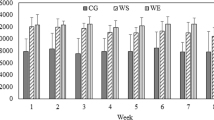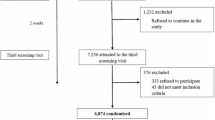Abstract
Purpose
The aim of this pilot study was to assess the impact of a physical activity program of walking 10,000 steps per day along with monthly dietary counseling on the body composition, biological parameters, resting energy expenditure (REE) and health-related quality of life (HRQoL) of obese individuals.
Methods
Thirty-five obese adults (26 women; age: 39.2 ± 13.4 years, body mass, BM: 104.1 ± 18.7 kg and body mass index, BMI: 38.3 ± 6.6 kg m−2) followed a walking program (instructions were provided so that the participants increase their walking distance by 1000 steps each week, until to perform at least 10,000 steps per day) and received qualitative dietary advice (cookbook presenting numerous recipes with low calories and dietary advices was provided) for 6 months. Before and after the intervention, anthropometric (BM, BMI, waist and hip circumferences, fat mass: FM and lean body mass: LBM) and biological data (total cholesterol, high-density lipoprotein, low-density lipoprotein, triglyceride and glucose concentrations), REE and HRQoL (including eight dimensions and two summaries) were assessed.
Results
After the intervention, BM (difference: 3.8 kg or 3.7 %), BMI (difference: 1.4 kg m−2 or 3.7 %), hip circumference (difference: 4.6 cm or 4.3 %), FM in kg (difference: 4.0 kg or 8.9 %) and FM in percentage of BM (difference: 1.6 kg or 6.1 %) were significantly decreased, whereas number of steps (difference: 7579 steps or 135 %), LBM in percentage of BM (difference: 2.6 kg or 4.5 %) and REE (difference: 78 kcal d−1 or 4.8 %) were significantly increased (p < 0.05). Moreover, two HRQoL subdimension scores (physical functioning and physical component summary; increase by 15.3 and 4.6, respectively, p < 0.05) and anxiety (reduction by 1.2, p < 0.05) were also significantly improved. Conversely, the biological data showed no significant change (p > 0.05).
Conclusion
Walking 10,000 steps per day in association with dietary counseling improved anthropometric data, REE, the physical domains of HRQoL and anxiety in obese adults.

Similar content being viewed by others
References
Jayaraj D, Nair PP, Napolean R, Stephen J, Nishanth K, Suresh D (2014) Prevalence of overweight and obesity among students of a medical college in South India: a pilot study. Indian J Clin Pract 25:333–337
Kolotkin RL, Meter K, Williams GR (2001) Quality of life and obesity. Obes Rev 2:219–229
Katz DA, McHorney CA, Atkinson RL (2000) Impact of obesity on health-related quality of life in patients with chronic illness. J Gen Intern Med 15:789–796
Fontaine KR, Bartlett SJ, Barofsky I (2000) Health-related quality of life among obese persons seeking and not currently seeking treatment. Int J Eat Disord 27:101–105
Kral JG, Sjostrom LV, Sullivan MB (1992) Assessment of quality of life before and after surgery for severe obesity. Am J Clin Nutr 55:611–614
Fontaine KR, Barofsky I, Andersen RE, Bartlett SJ, Wiersema L, Cheskin LJ, Franckowiak SC (1999) Impact of weight loss on health-related quality of life. Qual Life Res 8:275–277
Coquart J, Boitel G, Borel B, Duhamel A, Matran R, Delsart P, Mounier-Vehier C, Garcin M (in press) Exercise training at the crossover point improves bodily and cardiorespiratory data but not quality of life in women with metabolic syndrome. J Sports Med Phys Fit
Donnelly JE, Blair SN, Jakicic JM, Manore MM, Rankin JW, Smith BK (2009) Position stand appropriate physical activity intervention strategies for weight loss and prevention of weight regain for adults. Med Sci Sports Exerc 41:459–471
Strychar I (2006) Diet in the management of weight loss. CMAJ 174:56–63
Grief SN, Miranda RL (2010) Weight loss maintenance. Am Fam Physician 82:630–634
Sum CF, Wang KW, Choo DC, Tan CE, Fok AC, Tan EH (1994) The effect of a 5-month supervised program of physical activity on anthropometric indices, fat-free mass, and resting energy expenditure in obese male military recruits. Metabolism 43:1148–1152
Tudor-Locke C, Bassett DR (2004) How many steps/day are enough? Preliminary pedometer indices for public health. Sports Med 34:1–8
Kang M, Marshall SJ, Barreira TV, Lee JO (2009) Effect of pedometer-based physical activity interventions: a meta-analysis. Res Q Exerc Sport 80:648–655
Soroush A, Der Ananian C, Ainsworth BE, Belyea M, Poortvliet E, Swan PD, Walker J, Yngve A (2013) Effects of a 6-month walking study on blood pressure and cardiorespiratory fitness in U.S. and swedish adults: ASUKI step study. Asian J Sports Med 4:114–124
Tudor-Locke C, Swift DL, Schuna JM, Dragg AT, Davis AB, Martin CK, Johnson WD, Church TS (2014) Walkmore: a randomized controlled trial of pedometer-based interventions differing on intensity messages. BMC Public Health 15:168
Choi BC, Pak AW, Choi JC, Choi EC (2007) Daily step goal of 10,000 steps: a literature review. Clin Invest Med 30:146–151
Bravata DM, Smith-Spangler C, Sundaram V, Gienger AL, Lin N, Lewis R, Stave CD, Olkin I, Sirard JR (2007) Using pedometers to increase physical activity and improve health: a systematic review. JAMA 298:2296–2304
Melanson KJ, Dell’Olio J, Carpenter MR, Angelopoulos TJ (2004) Changes in multiple health outcomes at 12 and 24 weeks resulting from 12 weeks of exercise counseling with or without dietary counseling in obese adults. Nutrition 20:849–856
Lohman T, Martorell R, Roche A (1988) Anthropometric standardization reference manual. Reynaldo, Martorell
Friedewald WT, Levy RI, Fredrickson DS (1972) Estimation of the concentration of low-density lipoprotein cholesterol in plasma, without use of the preparative ultracentrifuge. Clin Chem 18:499–502
Alves VG, da Rocha EE, Gonzalez MC, da Fonseca RB, Silva MH, Chiesa CA (2009) Assessment of resting energy expenditure of obese patients: comparison of indirect calorimetry with formulae. Clin Nutr 28:299–304
Blond E, Maitrepierre C, Normand S, Sothier M, Roth H, Goudable J, Laville M (2011) A new indirect calorimeter is accurate and reliable for measuring basal energy expenditure, thermic effect of food and substrate oxidation in obese and healthy subjects. e-SPEN 6:7–15
Weir JB (1949) New methods for calculating metabolic rate with special reference to protein metabolism. J Physiol 109:1–9
Ware JE, Sherbourne CD (1992) The MOS 36-item short-form health survey (SF-36): conceptual framework and item selection. Med Care 30:473–483
Corica F, Corsonello A, Apolone G, Lucchetti M, Melchionda N, Marchesini G (2006) Construct validity of the short form-36 health survey and its relationship with BMI in obese outpatients. Obesity 14:1429–1437
Castres I, Folope V, Dechelotte P, Tourny-Chollet C, Lemaitre F (2010) Quality of life and obesity class relationships. Int J Sports Med 31:773–778
Coquart JB (2015) Optimal exercise intensity in obese individuals. J J Obes 1:016
Zigmond AS, Snaith RP (1983) The hospital anxiety and depression scale. Acta Psychiatr Scand 67:361–370
Miyatake N, Nishikawa H, Morishita A, Kunitomi M, Wada J, Suzuki H, Takahashi K, Makino H, Kira S, Fujii M (2002) Daily walking reduces visceral adipose tissue areas and improves insulin resistance in Japanese obese subjects. Diabetes Res Clin Pract 58:101–107
Richardson CR, Newton TL, Abraham JJ, Sen A, Jimbo M, Swartz AM (2008) A meta-analysis of pedometer-based walking interventions and weight loss. Ann Fam Med 6:69–77
Gulve EA (2008) Exercise and glycemic control in diabetes: benefits, challenges, and adjustments to pharmacotherapy. Phys Ther 88(11):1297–1321
Laaksonen DE, Lindström J, Lakka TA, Eriksson JG, Niskanen L, Wikström K, Aunola S, Keinänen-Kiukaanniemi S, Laakso M, Valle TT, Ilanne-Parikka P, Louheranta A, Hämäläinen H, Rastas M, Salminen V, Cepaitis Z, Hakumäki M, Kaikkonen H, Härkönen P, Sundvall J, Tuomilehto J, Uusitupa M (2005) Physical activity in the prevention of type 2 diabetes: the Finnish diabetes prevention study. Diabetes 54:158–165
Slentz CA, Houmard JA, Kraus WE (2009) Exercise, abdominal obesity, skeletal muscle, and metabolic risk: evidence for a dose response. Obesity 17:27–33
Swartz AM, Strath SJ, Bassett DR, Moore JB, Redwine BA, Groër M, Thompson DL (2003) Increasing daily walking improves glucose tolerance in overweight women. Prev Med 37:356–362
Bray GA (1969) Effect of caloric restriction on energy expenditure in obese patients. Lancet 2:397–398
Leibel RL, Hirsch J (1984) Diminished energy requirements in reduced-obese patients. Metabolism 33:164–170
Bosy-Westphal A, Müller MJ, Boschmann M, Klaus S, Kreymann G, Lührmann PM, Neuhäuser-Berthold M, Noack R, Pirke KM, Platte P, Selberg O, Steiniger J (2009) Grade of adiposity affects the impact of fat mass on resting energy expenditure in women. Br J Nutr 101:474–477
Araiza P, Hewes H, Gashetewa C, Vella CA, Burge MR (2006) Efficacy of a pedometer-based physical activity program on parameters of diabetes control in type 2 diabetes mellitus. Metabolism 55:1382–1387
Maehlm S, Grandmontagne M, Newsholme EA, Sejersted OM (1986) Magnitude and duration of excess post exercise oxygen consumption in healthy young subjects. Metabolism 35:425–429
Blissmer B, Riebe D, Dye G, Ruggiero L, Greene G, Caldwell M (2006) Health-related quality of life following a clinical weight loss intervention among overweight and obese adults: intervention and 24 month follow-up effects. Health Qual Life Outcomes 17:43
Kolotkin RL, Norquist JM, Crosby RD, Suryawanshi S, Teixeira PJ, Heymsfield SB, Erondu N, Nguyen AM (2009) One-year health-related quality of life outcomes in weight loss trial participants: comparison of three measures. Health Qual Life Outcomes 7:53
Kaukua J, Pekkarinen T, Sane T, Mustajoki P (2002) Health-related quality of life in WHO class II–III obese men losing weight with very-low-energy diet and behaviour modification: a randomised clinical trial. Int J Obes Relat Metab Disord 26:487–495
Verrotti A, Penta L, Zenzeri L, Agostinelli S, De Feo P (2014) Childhood obesity: prevention and strategies of intervention. A systematic review of school-based interventions in primary schools. J Endocrinol Invest 37:1155–1164
Acknowledgments
This project was not directly supported by any Grants or other financial assistance. Special thanks are given to Professor Pierre Dechelotte (Service de Nutrition, CHU Rouen; INSERM U1073) and Doctor Vanessa Folope (Service de Nutrition, CHU Rouen) for recruiting of subjects, the provision of materials and dietary counseling, but also the subjects for their cooperation.
Author information
Authors and Affiliations
Corresponding author
Ethics declarations
Conflict of interest
The authors declare that they have no conflict of interest.
Ethical approval
All procedures performed in this study were in accordance with the ethical standards of the institution and with the 1964 Helsinki declaration and its amendments.
Informed consent
All participants provided written informed consent.
Rights and permissions
About this article
Cite this article
Castres, I., Tourny, C., Lemaitre, F. et al. Impact of a walking program of 10,000 steps per day and dietary counseling on health-related quality of life, energy expenditure and anthropometric parameters in obese subjects. J Endocrinol Invest 40, 135–141 (2017). https://doi.org/10.1007/s40618-016-0530-9
Received:
Accepted:
Published:
Issue Date:
DOI: https://doi.org/10.1007/s40618-016-0530-9




